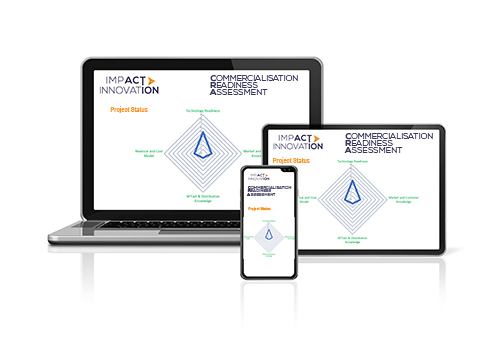
Why you need a common language for commercialisation
Posted 4 years ago
A shared understanding of what each stage in your commercialisation strategy entails will keep everyone on the team in sync for bringing the new product to market.
Commercialisation is a team sport, with the common goal of turning a novel idea into a new income stream. The different skillsets that come into play – technical, financial, operational, promotional – each have their own jargon and related interpretation of words and acronyms, so when the team comes together, sometimes communication doesn’t come naturally.
A Project Management Institute report revealed that ineffective communication is the main reason for project failure one-third of the time. It also has the biggest negative impact on project success more than half the time.
Even experienced R&D and innovation managers can find navigating the complexity of commercialisation tricky enough without the delays and mistakes that misunderstandings can cause. Communicating the meaning of terms in your commercialisation plan clearly and consistently will help to minimise these risks and accelerate progress.
Let’s look at some commercialisation language and why shared meanings matter.
What does it mean?
If you’re leading a team that’s taking a new idea to market and commercialisation capability is not yet on your resume, here are five common terms and their general meanings you should know.
1. Te chnology Readiness Level (TRL)
chnology Readiness Level (TRL)
TRLs estimate the maturity of a technology, usually based on a scale of 1-9, with 9 being closer to market readiness. Many R&D teams adopt the original NASA scoring, but your company might devise its own. Importantly, TRLs enable consistent, uniform discussions about the progress of each developing idea or technology in your pipeline.
We have based our Commercialisation Readiness Assessment tool on NASA’s scoring. It’s more useful for tracking a project’s development because it provides benchmarking and prompts along an idea’s commercialisation journey to identify where your time and resources should be focused.
2. Proof of Concept (PoC)
Historically, PoCs demonstrate that an idea can function as intended, based on experiment data. With so many new ideas competing for support, PoC studies now need to encompass more than the technology.
To get the backing to develop an idea further, your PoCs should also show the usability and profitability potential. Testing and validating assumptions about your business model will provide the commercial data required for potential investors to make the decision to support your idea.
3. Minimal Viable Product (MVP)
MVPs are the first versions of your product that include only the core features to help you test quickly and cheaply the riskiest assumptions (ideally with target customers) before adding advanced features.
You might create several prototypes to express your idea as you work out the technical elements (like safety and efficacy), then choose one as an MVP to share with customers for gathering data and insights relevant to commercial potential.
What you learn from customer or end-user feedback helps to confirm the problem your new idea is solving and refine how your solution can meet their needs and expectations.
4. Product-Market Fit (PMF)
This term is one of the most likely to be misinterpreted, so agreeing on what it means for all stakeholders is critical. For some, achieving PMF is as simple as getting the target customer excited to buy your product, as indicated by surveys, early adopters and initial purchases (i.e. it’s time to launch with fanfare).
Others see PMF as not being reached until users start promoting the product for you because they have had a good experience with it, so you gain enough customers in your target market to scale up and sustain profitability (the product seemingly launches itself).
And the money-minded people on the team might say it’s when your customer acquisition cost is lower than the customer life-time value (don’t send out the launch invitations just yet…).
The key is to ensure everybody understands that PMF is likely to be achieved via iterations – usually not something directly from the drawing board. Our Commercialisation Navigator tool was developed specifically to facilitate the conversations that teams need to have, to decrease risk and increase certainty.
5. Incubation
This is the period when technically proven ideas are commercially tested so that when they are launched onto the market, they have the best chance of success. This is sometimes called the ‘seed’ stage, when promising ideas are nurtured but also exposed to business elements to see how they might survive and thrive in the face of variables, such as customer types, competitive forces, revenue models, etc.
It’s when de-risking is the project focus, to create the best possible runway for market launch and future financial returns. It’s a proactive time that shouldn’t be confused with shelving or parking until resources become available, nor with keeping an idea just alive, just in case…
How does a common commercialisation language help?

By establishing shared meaning of commercialisation terms relevant to your industry you can manage expectations about when the idea or technology will be ready for the next stage of product development.
If a stakeholder makes assumptions based on a misinterpretation, the subsequent action could result in a delay at best… but it could also trigger something bigger. Clear and consistent communication de-risks the disaster factor.
Agreed terms also keep your commercialisation strategy reporting objective and succinct, which helps your readers understand quickly what might be slowing progress and what the project needs to move faster.
‘Shorthand’ or abbreviated terms that don’t require detailed explanations will make the comprehension and impact of your visual communication tools, such as graphs and flowcharts, more immediate.
Prioritising actions can be simplified, making the roadmap for bringing a product to market look more achievable and less onerous, especially for a small team.
Staying on track across product development, technical, operational, financial and marketing functions is easier to navigate when everyone sticks to the same terminology.
Ensuring your team and stakeholders share a common commercialisation language will protect your product development project from unnecessary delays and keep it on schedule for success. It doesn’t have to be a definitive dictionary – what matters is that everyone who needs to understand what’s happening can do so easily and objectively.
If you would like to make managing product development communication easier, our Commercialisation Navigator™ tool can provide a common language and framework for mapping out the plan. Learn more about the Commercialisation Navigator™ tool here.